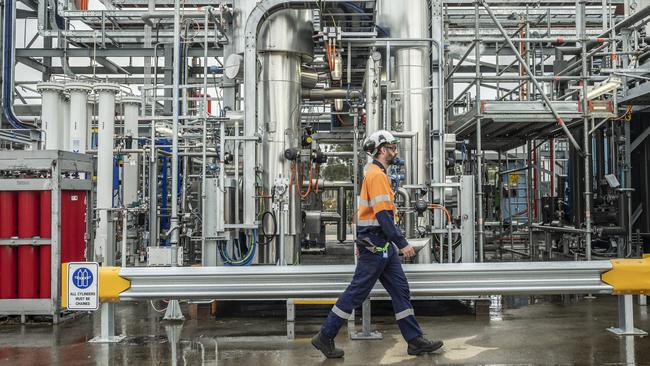Australia ‘could lead world in hydrogen’
Japanese companies have urged Australia to adopt regulatory changes to put the country in the box seat to become the world’s leading hydrogen producer.

The Japanese companies behind the world’s most advanced hydrogen projects have urged Australia to adopt regulatory changes to put the country in the box seat to become the world’s leading producer of the clean energy source, amid potential hurdles for one of the trial plants in Victoria.
Kawasaki Heavy Industries and Japan’s biggest refiner, Eneos, are locked in a race to commercialise key hydrogen technologies in partnership with Australia.
The Kawasaki project is the most advanced, producing hydrogen from brown coal in Victoria’s Latrobe Valley before shipping it in supercooled liquid form in a world-first voyage from Australia to Japan last year.
Eneos has opened a green hydrogen demonstration plant at Bulwer Island in Brisbane, and plans to export the fuel in a hydrogen carrier, methylcyclohexane (MCH), which remains liquid at normal temperatures.
Both projects are subsidised by Japan’s two trillion yen ($22.6bn) Green Innovation Fund, as the nation pushes to become the world’s first hydrogen-powered economy.
But there are concerns the Kawasaki project, which was recently allocated $2.35bn by the Japanese government, may face difficulties, after Victorian Energy and Climate Minister Lily D’Ambrosio declined to pledge ongoing support.
The company’s hydrogen strategy division manager, Shigeru Yamamoto, said the project was designed around fossil fuel-produced “blue hydrogen” because renewable energy was still too expensive for producing hydrogen at a commercial scale.
But Mr Yamamoto said the Victorian project would use carbon capture and storage technology to slash the amount of carbon dioxide created when the hydrogen was produced.
He said Australia should consider developing a “guarantee of origin” system to certify “clean hydrogen” shipments, based on the level of carbon emissions associated with its production.
“(If) Australia could be the first mover to some … certification system for blue hydrogen, then that would be an advantage,” Mr Yamamoto said.
Transporting liquid hydrogen presents technical challenges, because it must be maintained at a constant −253C.
But Kawasaki, which has 40 years experience in producing storage tanks to hold liquefied hydrogen for use as rocket fuel, believes the transportation method is the simplest, because it requires no complex conversion process.
“We have become even more confident since we’ve been successful in completing the pilot project,” Mr Yamamoto said.
Eneos believes its MCH method of hydrogen transportation will eventually come out on top, billing the technology as a method to export clean energy over long distances.
The technology combines hydrogen and toluene to create MCH, which contains more than 500 times more hydrogen by volume than hydrogen gas and can be moved at room temperature.
Eneos hydrogen group manager Dr Koji Matsuoka said the company’s Bulwer Island plant would generate 300,000 tonnes of hydrogen by 2030, and the company hoped to operate multiple such plants in the years that followed.
He said Australia could encourage the development of the domestic hydrogen industry by introducing laws to specifically regulate the sector.
“The country that is able to relax its laws and regulations to accommodate a hydrogen plant will be the winner in this market,” Dr Matsuoka said.
Ben Packham travelled to Japan as a guest of the Japanese government.








To join the conversation, please log in. Don't have an account? Register
Join the conversation, you are commenting as Logout